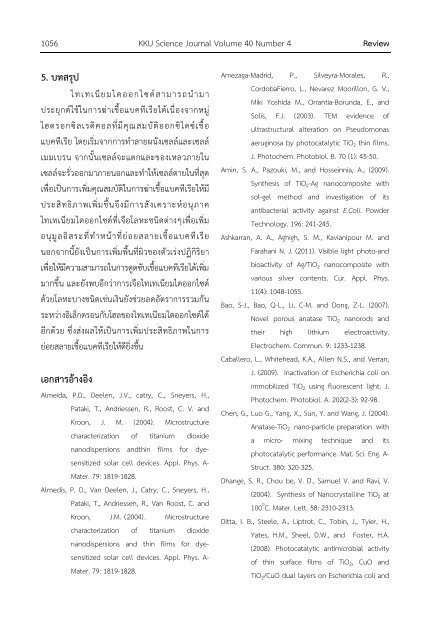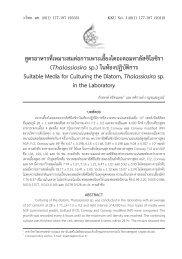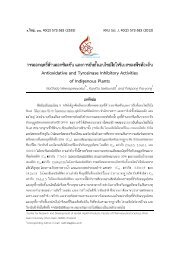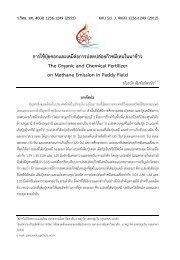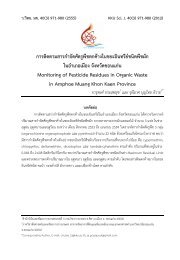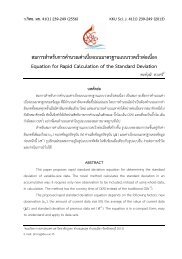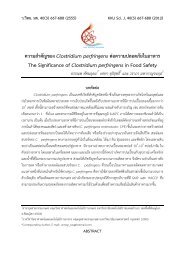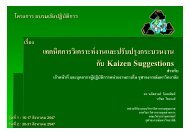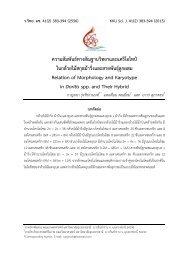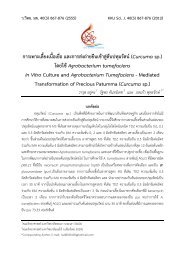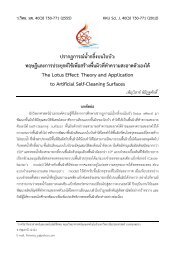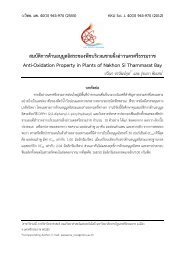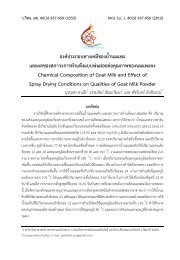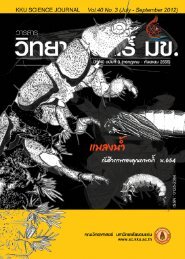à¹à¸à¹à¸à¹à¸à¸µà¸¢à¸¡à¹à¸à¸à¸à¸à¹à¸à¸à¹: วัสà¸à¸¸à¸à¹à¸²à¹à¸à¸·à¹à¸à¹à¸à¸à¸à¸µà¹à¸£à¸µà¸¢
à¹à¸à¹à¸à¹à¸à¸µà¸¢à¸¡à¹à¸à¸à¸à¸à¹à¸à¸à¹: วัสà¸à¸¸à¸à¹à¸²à¹à¸à¸·à¹à¸à¹à¸à¸à¸à¸µà¹à¸£à¸µà¸¢
à¹à¸à¹à¸à¹à¸à¸µà¸¢à¸¡à¹à¸à¸à¸à¸à¹à¸à¸à¹: วัสà¸à¸¸à¸à¹à¸²à¹à¸à¸·à¹à¸à¹à¸à¸à¸à¸µà¹à¸£à¸µà¸¢
Create successful ePaper yourself
Turn your PDF publications into a flip-book with our unique Google optimized e-Paper software.
1056 KKU Science Journal Volume 40 Number 4 Review<br />
5. บทสรุป<br />
ไทเทเนียมไดออกไซด์สามารถนํามา<br />
ประยุกต์ใช้ในการฆ่าเชื้อแบคทีเรียได้เนื่องจากหมู่<br />
ไฮดรอกซิลเรดิคอลที่มีคุณสมบัติออกซิไดซ์เชื้อ<br />
แบคทีเรีย โดยเริ่มจากการทําลายผนังเซลล์และเซลล์<br />
เมมเบรน จากนั้นเซลล์จะแตกและของเหลวภายใน<br />
เซลล์จะรั่วออกมาภายนอกและทําให้เซลล์ตายในที่สุด<br />
เพื่อเป็นการเพิ่มคุณสมบัติในการฆ่าเชื้อแบคทีเรียให้มี<br />
ประสิทธิภาพเพิ่มขึ้นจึงมีการสังเคราะห์อนุภาค<br />
ไทเทเนียมไดออกไซด์ที่เจือโลหะชนิดต่างๆเพื่อเพิ่ม<br />
อนุมูลอิสระที่ทําหน้าที่ย่อยสลายเชื้อแบคทีเรีย<br />
นอกจากนี้ยังเป็นการเพิ่มพื้นที่ผิวของตัวเร่งปฏิกิริยา<br />
เพื่อให้มีความสามารถในการดูดซับเชื้อแบคทีเรียได้เพิ่ม<br />
มากขึ้น และยังพบอีกว่าการเจือไทเทเนียมไดออกไซด์<br />
ด้วยโลหะบางชนิดเช่นเงินยังช่วยลดอัตราการรวมกัน<br />
ระหว่างอิเล็กตรอนกับโฮลของไทเทเนียมไดออกไซด์ได้<br />
อีกด้วย ซึ่งส่งผลให้เป็นการเพิ่มประสิทธิภาพในการ<br />
ย่อยสลายเชื้อแบคทีเรียให้ดียิ่งขึ้น<br />
เอกสารอ้างอิง<br />
Almeida, P.D., Deelen, J.V., catry, C., Sneyers, H.,<br />
Pataki, T., Andriessen, R., Roost, C. V. and<br />
Kroon, J. M. (2004). Microstructure<br />
characterization of titanium dioxide<br />
nanodispersions andthin films for dyesensitized<br />
solar cell devices. Appl. Phys. A-<br />
Mater. 79: 1819-1828.<br />
Almedis, P. D., Van Deelen, J., Catry, C., Sneyers, H.,<br />
Pataki, T., Andriessen, R., Van Roost, C. and<br />
Kroon, J.M. (2004). Microstructure<br />
characterization of titanium dioxide<br />
nanodispersions and thin films for dyesensitized<br />
solar cell devices. Appl. Phys. A-<br />
Mater. 79: 1819-1828.<br />
Amezaga-Madrid, P., Silveyra-Morales, R.,<br />
CordobaFierro, L., Nevarez Moorillon, G. V.,<br />
Miki Yoshida M., Orrantia-Borunda, E., and<br />
Solis, F.J. (2003). TEM evidence of<br />
ultrastructural alteration on Pseudomonas<br />
aeruginosa by photocatalytic TiO 2 thin films.<br />
J. Photochem. Photobiol. B. 70 (1): 45-50.<br />
Amin, S. A., Pazouki, M., and Hosseinnia, A., (2009).<br />
Synthesis of TiO 2 -Ag nanocomposite with<br />
sol-gel method and investigation of its<br />
antibacterial activity against E.Coli. Powder<br />
Technology. 196: 241-245.<br />
Ashkarran, A. A., Aghigh, S. M., Kavianipour M. and<br />
Farahani N. J. (2011). Visible light photo-and<br />
bioactivity of Ag/TiO 2 nanocomposite with<br />
various silver contents. Cur. Appl. Phys.<br />
11(4): 1048-1055.<br />
Bao, S-J., Bao, Q-L., Li, C-M. and Dong, Z-L. (2007).<br />
Novel porous anatase TiO 2 nanorods and<br />
their high lithium electroactivity.<br />
Electrochem. Commun. 9: 1233-1238.<br />
Caballero, L., Whitehead, K.A., Allen N.S., and Verran,<br />
J. (2009). Inactivation of Escherichia coli on<br />
immobilized TiO 2 using fluorescent light. J.<br />
Photochem. Photobiol. A. 202(2-3): 92-98.<br />
Chen, G., Luo G., Yang, X., Sun, Y. and Wang, J. (2004).<br />
Anatase-TiO 2 nano-particle preparation with<br />
a micro- mixing technique and its<br />
photocatalytic performance. Mat. Sci. Eng. A-<br />
Struct. 380: 320-325.<br />
Dhange, S. R., Chou be, V. D., Samuel V. and Ravi, V.<br />
(2004). Synthesis of Nanocrystalline TiO 2 at<br />
100 o C. Mater. Lett. 58: 2310-2313.<br />
Ditta, I. B., Steele, A., Liptrot, C., Tobin, J., Tyier, H.,<br />
Yates, H.M., Sheel, D.W., and Foster, H.A.<br />
(2008). Photocatalytic antimicrobial activity<br />
of thin surface films of TiO 2 , CuO and<br />
TiO 2 /CuO dual layers on Escherichia coli and


